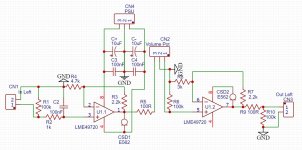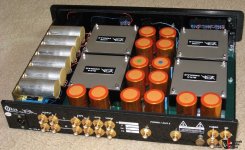G'day Guys,
A question of theory or best practice or some such.
For something like a fairly generic OPamp based preamp, is a regulated PSU really that important?
For example:

Does a regulator eg: 7815/7915 or LM317/LM337 etc actually offer a noticeable performance benefit over just bulk caps or a CRC psu?
Isn't the PSRR of modern OPamps such that regulation is perhaps unnecessary?
A question of theory or best practice or some such.
For something like a fairly generic OPamp based preamp, is a regulated PSU really that important?
For example:

Does a regulator eg: 7815/7915 or LM317/LM337 etc actually offer a noticeable performance benefit over just bulk caps or a CRC psu?
Isn't the PSRR of modern OPamps such that regulation is perhaps unnecessary?
"Really necessary" probably not in the sense that the PSRR of most opamps will render any reasonable degree of ripple inaudible. But to get reasonable ripple you would have to use bulk capacitors that cost more than simple voltage regulators. So regulation is cost effective ... and it has clear benefits. So why would you ever not want to use it?
Based on experience I'd say 'yes, regulation is essential'. An LM317 regulator gives an audible improvement in noise floor even compared to my linear regulated bench supply.
PSRR is not the only issue - the PSRR is the asymptote assuming your decoupling layout is perfect.
PSRR is not the only issue - the PSRR is the asymptote assuming your decoupling layout is perfect.
I made cassette player tapeheads preamps and phono preamps with no regulator based only on op-amps psrr.It works.You just need good grounding and shielding.The true reason for using regulators is to have stable rails so that you won't burn your op-amps if it's going over the max V supply acceptable by the op-amps.If your circuits don't have a great psrr, a cap multiplier will do the job any day.You don't need huge caps for op-amp preamps ...47...470uf are good enough for most preamps.
Apply the logic in reverse: what is there to gain when not using regulation?
Valve preamplifiers with considerably worse PSRR than op-amps are often supplied from a well-filtered, but unregulated supply, so that should also work for op-amp circuits. A minor disadvantage is the less predictable headroom. Power efficiency can be both better and worse, depending on the voltage drop across the filter and the regulator, but is not much of a concern for a preamplifier anyway.
It makes sense to have the very low power opamp device with the smallest signal levels having no voltage regulation and no 60 dB ripple reduction as the opamps PSRR will take care of that....
In slightly bent analogy it then also makes sense to have cheaper octangle car wheels as the suspension and shock absorbers will take care of the shocks. It helps to use flat roads too.
In slightly bent analogy it then also makes sense to have cheaper octangle car wheels as the suspension and shock absorbers will take care of the shocks. It helps to use flat roads too.
Last edited:
Price.Apply the logic in reverse: what is there to gain when not using regulation?
Simplicity.
Hobby World is one thing, Commercial World completely different.
And in one particular area, such as 9V battery powered preamps, such as those inside active Instruments or pedals (even a Guitar Distortion pedal IS a Preamp, only designed to clip), regulating is a handicap to be avoided, since it wastes either significant voltage (remember even full 9V is barely enough) or current, significantly decreasing battery life.
And I´m not talking about marginal or fringe areas, these products are made and used by the Millions.
Last edited:
In the past Sony used to have output stages with opamps in CD players fed with quite low voltage unregulated power. One of the mods that had effect was implementation of a small +/- 9V regulated PSU.
For hobby one also needs the filter caps and rectifiers anyway so the 2 x 50 cents for 7812/7912 won’t break the bank. Value of the filter caps can then be smaller as well. Without regulators large expensive caps and possibly CRC or CLC to have clean power so 2 x coil or power resistor extra.
It feels like debating that water is wet.
For hobby one also needs the filter caps and rectifiers anyway so the 2 x 50 cents for 7812/7912 won’t break the bank. Value of the filter caps can then be smaller as well. Without regulators large expensive caps and possibly CRC or CLC to have clean power so 2 x coil or power resistor extra.
It feels like debating that water is wet.
Last edited:
It feels like debating that water is wet.
Not quite, as there are dissenting views.
A good example being Sutherland Engineering. A choice between multistage RC filtering and several battery types but no active regulation.
Imho the use of regulation in opamp circuits is more of an aesthetic rather than technical choice. A good unregulated PS is obviously much more expensive and bulky, especially when chokes are added.
A tiny fraction of Sutherland's products use batteries Not sure if their current lineup even has a battery powered model. Otoh, adding regulation to battery power is a great way to get a handle on what regulation does musically. Not all good ime.
Some walkmans (portable cd players included) used op amps who's max voltage limit was 3.5...4.5v.So you can't mod anything...Some of today's professional soundcards are using headphones op amps limited at 3...5 V max supply...In the past Sony used to have output stages with opamps in CD players fed with quite low voltage unregulated power. One of the mods that had effect was implementation of a small +/- 9V regulated PSU.
For hobby one also needs the filter caps and rectifiers anyway so the 2 x 50 cents for 7812/7912 won’t break the bank. Value of the filter caps can then be smaller as well. Without regulators large expensive caps and possibly CRC or CLC to have clean power so 2 x coil or power resistor extra.
It feels like debating that water is wet.
Of course it's not a big expense to add some regulation, but I'd consider regulating opa2228 only if i go past +-9v supply to prevent supply spikes or voltage transients as that's an expensive op-amp.
Other than that i used to test , fix and callibrate professional high voltage smps (up to 300kV, 10kWatts, 50...100khz sw freq ) with all loops ran on opa2227 and supplied from another single ended smps syncd to main switcher.Those loops were making measurements down to mV range surrounded by killowats of switching powers as both cmrr and psrr were sublime.
Just try any of them and tell the results.
It is not customary to compare completely different setups/installations. This thread is about a preamp with a few opamps and symmetric power supply rails. In general these are fed regulated voltage as caps are small to cut costs.
In the schematic we see just a few 10 uF decoupling caps. If the focus is on low ripple then a larger and more expensive unregulated PSU can be done by an experienced DIYer. Chances of success are probably higher when recommending OP 2 x 1000 or 2200 uF and regulators.
Batteries, walkmans (walkmen? 😉) high voltage, industrial stuff and production numbers in the millions are a different league.
In the schematic we see just a few 10 uF decoupling caps. If the focus is on low ripple then a larger and more expensive unregulated PSU can be done by an experienced DIYer. Chances of success are probably higher when recommending OP 2 x 1000 or 2200 uF and regulators.
Batteries, walkmans (walkmen? 😉) high voltage, industrial stuff and production numbers in the millions are a different league.
Last edited:
His example is not a preamplifier...its gain is negative..
If he chooses a high supply(+-12...+-22v)depending on the op amp he'll will need a voltage reg for op-amp's protection. 22...100 ohm series resistor inside a pi crc filter(like 100uf- 22 ohm-100nf ) will solve any problem linked to high frequency psrr.
If he chooses a high supply(+-12...+-22v)depending on the op amp he'll will need a voltage reg for op-amp's protection. 22...100 ohm series resistor inside a pi crc filter(like 100uf- 22 ohm-100nf ) will solve any problem linked to high frequency psrr.
And there are those on the fringes who extol the benefits of using half wave rectification with single diode and a cap. K&K Rakk DAC unregulated power supply was claimed to be much better than a regulated one . YBA Alpha 1 $$$$ preamp which I have also have single rail unregulated RC power supply . Granted it has very nice and hefty cut core power transformer and premium quality ERO caps but still only RC cells with 4700uF caps.
Good passive PSU is probably more expensive than a regulator which costs pretty much nothing ...
When ripple and other stuff simple do not occur on the rails then one does not need to rely on PSRR. So opamps with less good PSRR may be used too as opamp rolling is a popular game. High chance that a fridge that starts won't be heard over the HiFi. Simplified we could say that undesired stuff that does not come in does not need to be processed/attenuated/filtered.
Passive unregulated PSUs may sound better when done right. Same category as unshielded interlinks that may sound better. Exceptions to the rules confirm the rules. I have heard quite some of these DIY setups and experiments but there is always something detrimental coming with such design choices. It depends if one likes to accept those. The risk of accepting is that after a while the setup is kind of a chaos.
Also beware of HF/RF. The smart phone test is a nice one to see if stuff is relatively immune. Today one can have a hard time to have clean rails and no HF/RF coming in various ways. Ferrite beads are handy parts for this.
I added pictures of the YBA Alpha 1 so it is clear that unregulated means careful execution for good results.
Passive unregulated PSUs may sound better when done right. Same category as unshielded interlinks that may sound better. Exceptions to the rules confirm the rules. I have heard quite some of these DIY setups and experiments but there is always something detrimental coming with such design choices. It depends if one likes to accept those. The risk of accepting is that after a while the setup is kind of a chaos.
Also beware of HF/RF. The smart phone test is a nice one to see if stuff is relatively immune. Today one can have a hard time to have clean rails and no HF/RF coming in various ways. Ferrite beads are handy parts for this.
I added pictures of the YBA Alpha 1 so it is clear that unregulated means careful execution for good results.
Attachments
Last edited:
- Home
- Source & Line
- Analog Line Level
- Is regulation really necessary/desirable for preamps?

